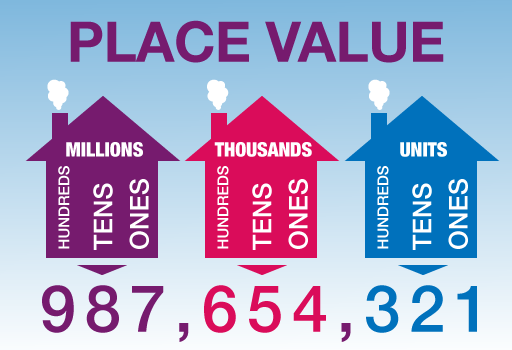1.1 Positive numbers and place value
Let’s look at positive numbers in more detail.
The place value of a digit in a number depends on its position or place in the number:
The value of 8 in 58 is 8 units.
The value of 3 in 34 is 3 tens.
The value of 4 in 435 is 4 hundreds.
The value of 6 in 6,758 is 6 thousands.
Look at the following example, which shows the place value of each digit in a seven-digit number.
Example: What’s in a number?
Take the number 9,046,251. The value of each digit is as follows:
9 millions
0 hundred thousands
4 ten thousands (or 40 thousand)
6 thousands
2 hundreds
5 tens
1 unit
To make large numbers easier to read, we put them in groups of three digits starting from the right:
6532 is often written as 6,532 (or 6 532).
25897 is often written as 25,897 (or 25 897).
596124 is often written as 596,124 (or 596 124).
7538212 is often written as 7,538,212 (or 7 538 212).
Use the example above to help you with the following activity. Remember to check your answers once you have completed the questions.
Activity 1: Working with place value
- Write 4,025 in words.
| Th | H | T | U |
|---|---|---|---|
| 4 | 0 | 2 | 5 |
Answer
4,025 in words is four thousand and twenty-five.
- Write six thousand, four hundred and seventy-two in figures.
| Th | H | T | U |
|---|---|---|---|
| six | four | seven | two |
Answer
Six thousand, four hundred and seventy-two in figures is 6,472.
Here are the results of an election to be school governor at Hawthorn School:
- John Smith: 436 votes
- Sonia Cedar: 723 votes
- Pat Kane: 156 votes
- Anjali Seedher: 72 votes
Who won the election?
Check your answer with our feedback before continuing.
Answer
The person who wins the election is the person who gets the most votes.
To find the biggest number we need to compare the value of the first digit in each number. If this is the same for any of the numbers, then we need to go on to compare the value of the second digit in each number and so on.
- The value of the first digit in 436 is 4 hundreds.
- The value of the first digit in 723 is 7 hundreds.
- The value of the first digit in 156 is 1 hundred.
- The value of the first digit in 72 is 7 tens.
Comparing the values of the first digit in each number tells us that the biggest number is 723, so Sonia Cedar is the winner of the election.

